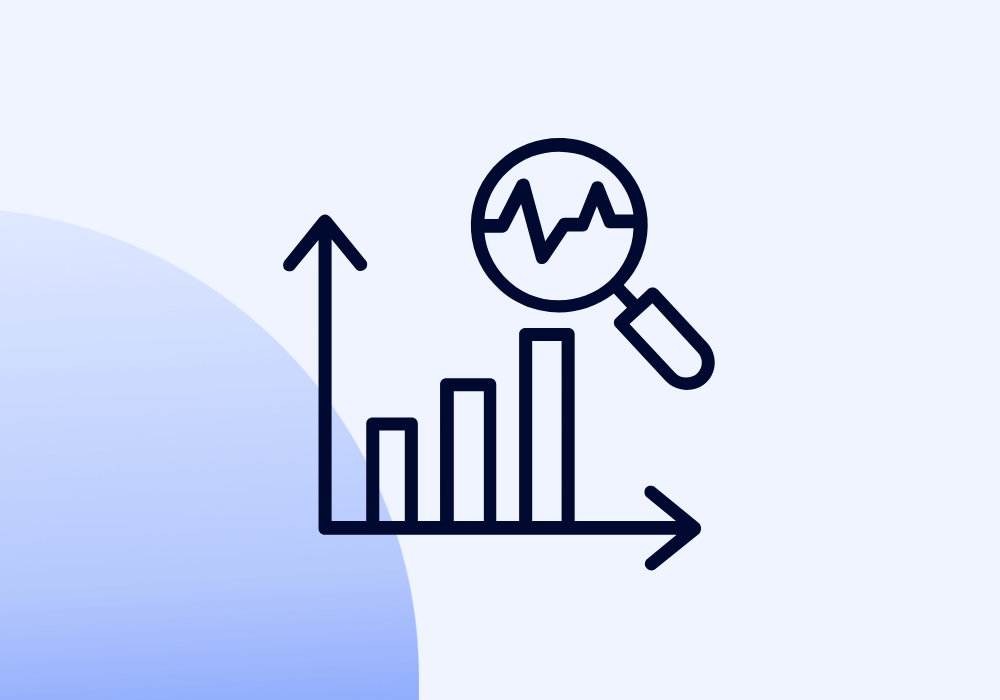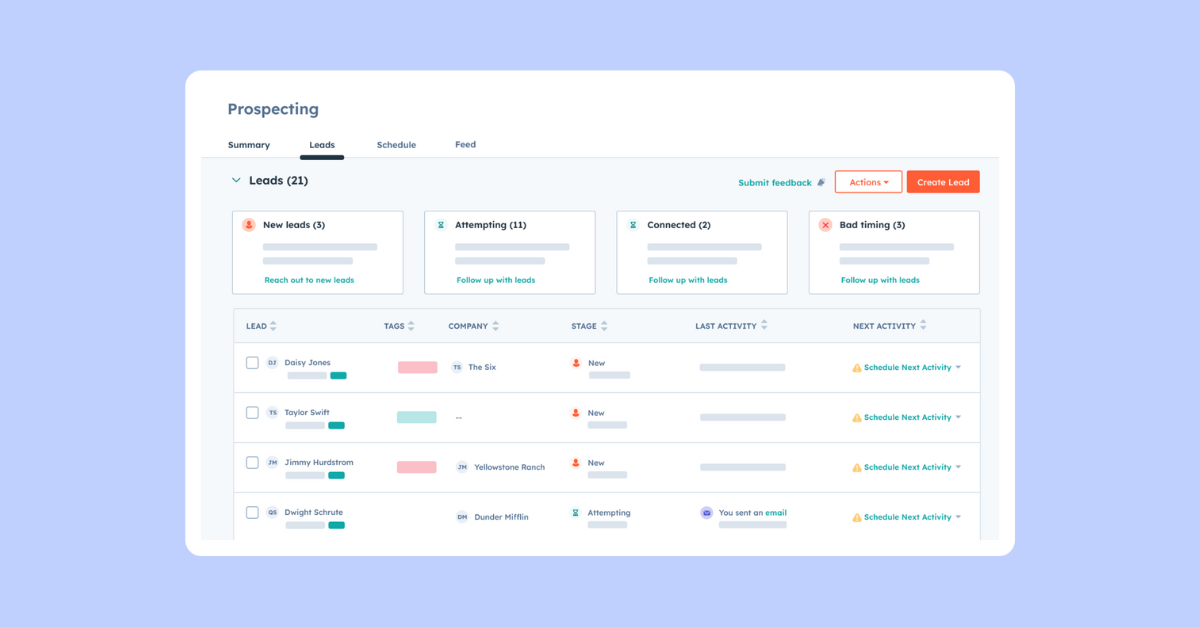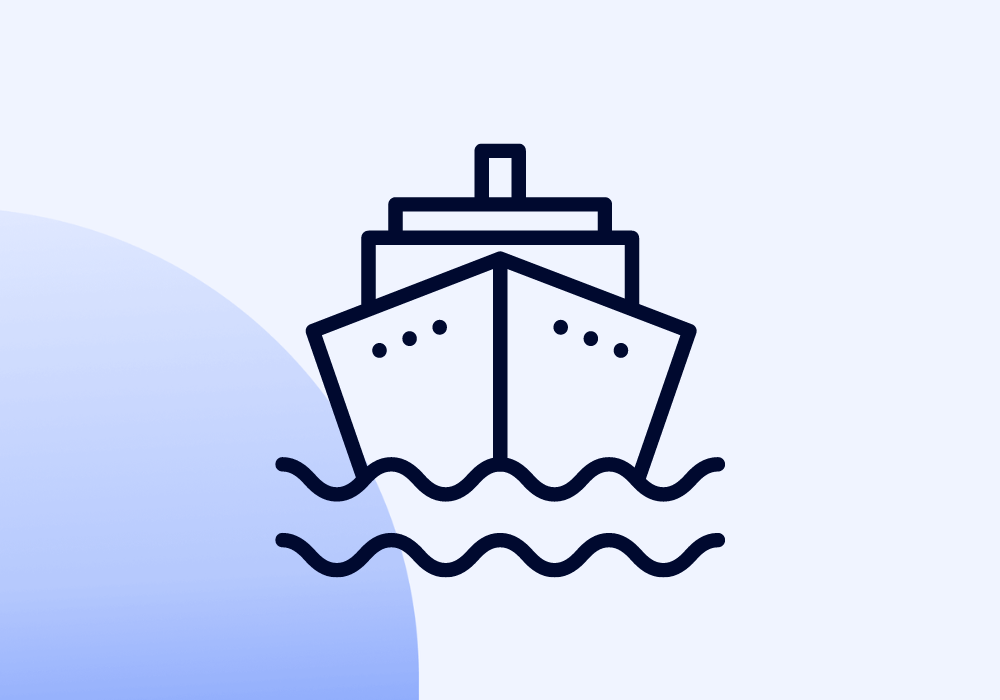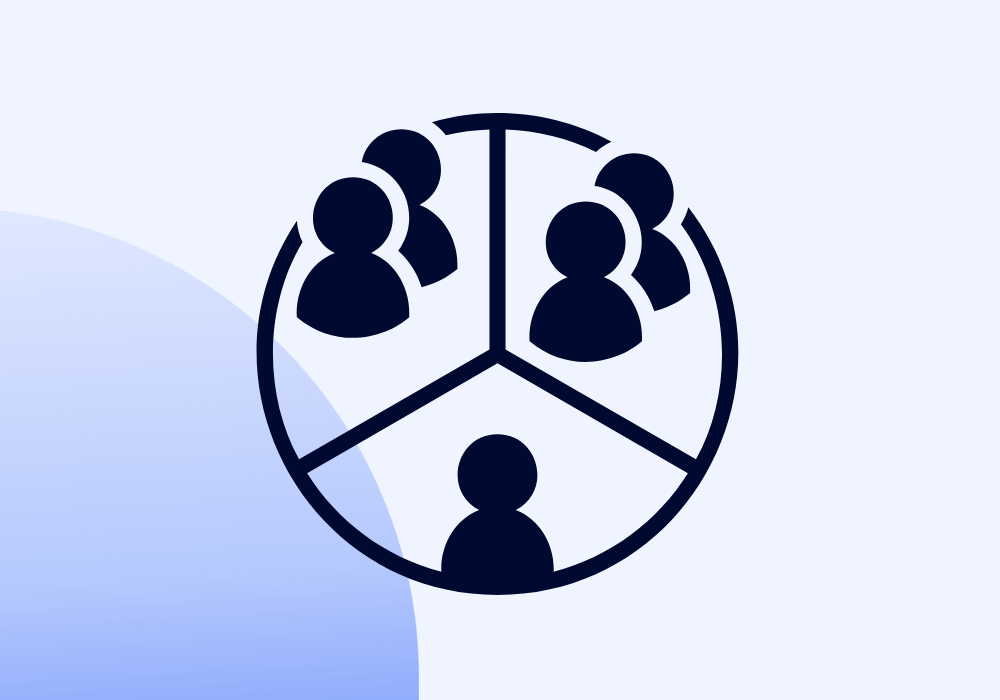How to Build a World-class Outbound Process With HubSpot
Top AI-Driven Sales Prospecting Tools That Integrate with HubSpot

Sales prospecting is critical to any successful sales strategy, particularly in specialized industries.
With the advancement of artificial intelligence (AI), sales teams can now leverage powerful tools to automate and enhance their prospecting efforts, leading to more meetings and deals.
KEY TAKEAWAYS
-
Sales prospecting is essential for maintaining a sales pipeline, particularly in specialized industries with a narrow and small target market.
-
AI-driven tools can significantly enhance your prospecting efforts by automating lead generation, enriching data, and enabling personalized outreach at scale.
-
Clay offers robust data enrichment and automation capabilities, allowing you to create detailed prospect profiles and automate outreach efforts.
-
Ocean uses AI to replicate your best customers and precisely target new prospects, helping you focus on high-quality leads.
-
Expandi automates LinkedIn outreach, allowing you to scale your prospecting efforts with personalized messaging campaigns.
-
Surfe seamlessly integrates LinkedIn data with HubSpot, streamlining CRM management and tracking all prospect interactions.
-
Hunter provides accurate email verification, making it ideal for cold email campaigns.
-
Loom adds a personal touch to outreach efforts through video messaging, helping you stand out in crowded inboxes.
This article will guide you through the top AI-driven prospecting tools that integrate seamlessly with HubSpot, helping your team work smarter, not harder.
Table of Contents
- What is Sales Prospecting?
- How to Succeed with Sales Prospecting
- The Benefits of Using AI Sales Tools
- Ocean. - AI-driven lookalike search and targeting
- Clay - Data integration and enrichment tool
- Expandi - LinkedIn outreach automation
- Surfe - Sync LinkedIn data to HubSpot.
- Hunter - Email finding and verification
- Loom - Personalized video messaging
What is Sales Prospecting?
Sales prospecting is the critical first step in the sales process, where potential customers, or "prospects," are identified and engaged.
It’s about finding the right people interested in your solution and contacting them to initiate a conversation. The goal is to build a pipeline of qualified leads who can eventually become customers.
Traditionally, sales prospecting was a manual, time-consuming task involving cold calls, door-to-door visits, or sending out mass mailers. Sales teams relied heavily on their networks, business directories, and manual research to find leads.

This approach, while foundational, was labor-intensive and often yielded low conversion rates due to the broad, non-targeted nature of the outreach.
However, with the advent of digital technology, the landscape of sales prospecting has dramatically evolved. Today, prospecting is increasingly driven by data, digital tools, and, most notably, artificial intelligence (AI).
Sales prospecting is the critical first step in the sales process, where potential customers, or 'prospects,' are identified and engaged.
AI-powered tools can analyze vast amounts of data to identify high-potential prospects, automating much of the manual work that used to consume hours of a salesperson's day.
Evolution of Sales Prospecting
The evolution of sales prospecting from traditional methods to AI-driven approaches is a significant shift in how businesses approach lead generation.
In the past, sales teams would spend countless hours sifting through lists and manually reaching out to potential leads with generic pitches.
The introduction of customer relationship management (CRM) systems began to streamline this process, allowing salespeople to track interactions, manage contacts, and nurture leads more effectively.
However, these systems still required extensive manual input and effort to maintain and were limited by the quality and quantity of the data entered.
The shift from traditional to AI-driven sales prospecting marks a major change in how businesses approach lead generation.
Today, AI has taken sales prospecting to the next level. By leveraging machine learning algorithms and predictive analytics,
AI tools can identify potential leads and predict which prospects are most likely to convert. This allows sales teams to focus their efforts on high-value targets, improving the efficiency and effectiveness of their outreach.
Moreover, AI tools can integrate with CRMs like HubSpot, automating the data entry process, enriching contact information, and suggesting the best times to reach prospects based on their past behavior.
This integration ensures that sales teams continuously work with the most up-to-date and relevant information, making their prospecting efforts more targeted and personalized.
Importance in the Sales Process
Sales prospecting is the foundation of the sales pipeline. The sales process can halt without a steady stream of qualified leads. Effective prospecting ensures that sales teams have a pool of potential customers to engage with, which is crucial for maintaining momentum and achieving sales targets.
In the context of B2B, sales is even more critical.
The sales cycles in these industries are often longer, and the decision-making processes are more complex, meaning that the quality of leads is paramount.
AI tools can sift through large amounts of data to pinpoint high-potential leads, automating tasks that once took up hours of a salesperson's time.
AI-driven prospecting tools help identify high-quality leads more efficiently, allowing sales teams to invest their time and resources where they’re most likely to see a return.
Challenges in Sales Prospecting
Despite advancements in technology, sales prospecting still presents several challenges.
One of the most significant is the sheer volume of data available.
With so much information at their fingertips, sales teams sometimes struggle to separate valuable leads from noise. AI tools can play a pivotal role in this process, helping to sift through data and highlight the most promising prospects.
Another challenge is maintaining a personalized approach at scale. As sales teams grow and the number of leads increases, it becomes more difficult to engage each prospect meaningfully.
However, AI tools can automate much of the personalization process, using data to tailor outreach efforts and make each interaction more relevant to the prospect.
In summary, sales prospecting is an essential component of the sales process, and its evolution from traditional to AI-driven methods has made it more efficient and effective.
However, careful management is still required to overcome challenges like data overload and maintaining personalization at scale.
How to Succeed with Sales Prospecting?
Succeeding in sales prospecting is about more than just identifying potential leads—it's about building a sustainable process that consistently generates high-quality prospects and nurtures them effectively through the sales pipeline.
In today’s competitive landscape, particularly within specialized industries like maritime technology, sales teams must balance volume with precision, ensuring they reach the right prospects without sacrificing the quality of their outreach.
Emphasizing Prospect Volume
One of the core principles of successful sales prospecting is maintaining a large pool of prospects.
The logic is simple: the more people you reach out to, the higher your chances of finding those who are genuinely interested in your product or service.
However, achieving this at scale can be challenging, mainly when relying on traditional methods. This is where AI tools shine.
AI-powered prospecting tools can quickly analyze vast amounts of data, identifying potential leads that meet your specific criteria.
Effective prospecting is crucial for keeping a steady flow of potential customers in the pipeline, ensuring momentum and helping achieve sales goals.
By automating the initial stages of prospecting—such as data collection, lead scoring, and qualification—AI enables sales teams to build a substantial prospect list without the manual legwork that typically accompanies this process. This allows sales teams to cast a wider net while targeting the right audience.
Role of AI in Sourcing Prospects
AI doesn't just increase the volume of prospects but also enhances the lead quality.
AI tools can sift through large datasets, utilizing advanced algorithms to identify highly relevant prospects for your business.
These tools can evaluate various factors—such as industry, company size, online behavior, and engagement patterns—to identify leads that are more likely to convert.
For example, AI tools integrated with HubSpot can automate importing and updating contact information, ensuring your CRM is always filled with fresh, relevant data.
This automation reduces the likelihood of human error and ensures that your sales team always works with the most accurate information.
Additionally, AI can help prioritize leads by predicting which ones are most likely to respond, allowing your sales team to focus their efforts on the most promising prospects.
Cost Efficiency and Time Management
One of the standout benefits of using AI in sales prospecting is its significant cost savings.
By automating time-consuming tasks, AI reduces the need for manual labor, saving time and lowering operational costs. Sales teams can achieve more with less, scaling their outreach efforts without additional resources.
With AI handling the more tedious aspects of prospecting, salespeople can focus on high-leverage activities such as relationship-building and closing deals.
This shift improves overall productivity and enhances job satisfaction, as sales teams can concentrate on the parts of their jobs that require human intuition and creativity.
AI-driven sales prospecting tools enable businesses to succeed by increasing prospect volume, improving lead quality, and delivering significant cost and time efficiencies.
By leveraging these tools, sales teams can reach a broad audience while maintaining the precision needed to convert leads into customers.
The Benefits of Using AI Sales Tools
Integrating AI into your sales process isn’t just about keeping up with the latest trends—it’s about unlocking tangible benefits that can dramatically enhance your team’s performance and results.
AI sales tools bring advantages that streamline operations, boost efficiency, and ultimately lead to more successful outcomes.
Here’s how these tools can transform your sales prospecting efforts:
1. Cost Savings
One of the most significant advantages of AI sales tools is the cost savings they offer. By automating repetitive and time-consuming tasks, AI reduces the need for extensive manual labor.
Your sales team can achieve more without increasing headcount or operational costs. For instance, tasks like data entry, lead scoring, and follow-up reminders can all be handled by AI, freeing up your team to focus on higher-value activities such as closing deals and building relationships.
Moreover, AI tools can scale your sales efforts without a proportional cost increase.
As your business grows and your prospecting needs expand, AI can handle larger volumes of data and leads without requiring additional resources.
This scalability is particularly valuable for B2B companies in niche markets like maritime technology, where finding the right prospects can be challenging and resource-intensive.
2. Improved Job Satisfaction
By taking over the more tedious aspects of sales prospecting, AI tools allow your salespeople to concentrate on what they do best—building relationships, understanding customer needs, and closing deals.
This shift not only increases productivity but also enhances job satisfaction. Sales professionals are often motivated by the impact they can make, and by empowering them with better insights and more meaningful work, AI reduces the risk of burnout and stress.
When salespeople spend less time on administrative tasks and more time on high-leverage activities, they feel more engaged and fulfilled in their roles. This improves individual performance and contributes to a more positive and motivated sales team.
3. Better Customer Engagement
AI tools excel at personalizing outreach efforts, enabling your team to engage with prospects more meaningfully. By leveraging data, AI can tailor communications to each prospect’s interests and needs, creating a more personalized and relevant experience.
For instance, AI can customize subject lines, email content, and even timing based on the prospect's previous interactions and behavior patterns.
This level of personalization fosters stronger connections with prospects, as they are more likely to respond positively to messages that feel tailored to them.
Additionally, AI can help your team stay on top of follow-ups, ensuring no lead falls through the cracks. This proactive approach improves engagement rates and builds trust and rapport with potential customers.
4. Faster Sales Cycle
AI can accelerate sales by automating key stages and enabling real-time responses. For example, AI can quickly qualify leads based on predefined criteria, ensuring that only the most promising prospects move forward in the sales funnel.
This reduces the time spent on unqualified leads and lets your team focus on quickly closing deals.
Moreover, AI tools can automate follow-ups and reminders, ensuring prospects are consistently engaged and moved through the sales process without delays.
This continuous, real-time interaction helps to maintain momentum, reducing the time it takes to convert a lead into a customer.
In summary, AI sales tools offer many benefits that can transform your sales process—from cost savings and enhanced efficiency to improved job satisfaction, customer engagement, and a faster sales cycle.
Integrating these tools into your sales strategy can improve your team’s performance and create a more scalable and sustainable approach to prospecting.
In the next section, we'll dive into the top sales prospecting tools that integrate with HubSpot—tools that can take your AI-driven sales strategy to the next level.
The Top Sales Prospecting Tools that Integrate with HubSpot
Integrating AI-powered tools into your sales prospecting process can yield significant benefits, especially when these tools seamlessly integrate with a robust CRM like HubSpot.
The right tools can automate and enhance various aspects of prospecting, from lead generation to personalized outreach, making your sales process more efficient and effective.
Here, we'll explore some of the top sales prospecting tools that integrate well with HubSpot, helping you to supercharge your sales efforts.
1. Ocean.io
Ocean's standout feature is its AI-driven lookalike search and precise targeting of people and companies. It also integrates with HubSpot, allowing you to import lead data directly into your CRM.

A lookalike search in Ocean.io enables you to replicate your existing happy customers at scale. Instead of wasting time on unqualified leads, you can use Ocean.io’s Lookalike Search to find prospects that closely match your best-fit customers.
Ocean identifies companies with similar characteristics by simply providing the domain of a current best-fit customer and a clear understanding of your Ideal Customer Profile (ICP).
This allows you to expand your customer base with leads most likely to convert.
Instead of broad or random outreach, the tool can pinpoint specific people and companies that align with your ICP. This targeted approach ensures that your sales efforts are not just broad but intelligent—focusing on the prospects most likely to be interested in your offerings.
2. Clay
Clay is a highly versatile tool that functions like a powerful spreadsheet that can pull in data from other databases and prospecting tools via APIs. It excels at sourcing and enriching your database by pulling data from various sources.

For instance, Clay can do waterfall enrichment to tap into 75+ databases, ensuring maximum coverage. This means you can get the best data from multiple sources into one Clay table.
Clay can get emails from Hunter.io, retrieve LinkedIn profile URLs from MixRank, or get a company's tech stack and consolidate this information into a single, organized table of companies and contacts.
This table can then be easily imported into CRM systems like HubSpot, ensuring all relevant data is accessible in one place.
Clay automates the lead generation process by sourcing potential prospects, gathering relevant data, and organizing it efficiently in a single table. By connecting to multiple data sources, Clay.io ensures your leads are enriched with the most current and comprehensive information.
Clay also helps gather data and leverages this data to write personalized email messages.
This feature allows you to scale your outbound system while maintaining a high level of personalization. By automating the creation of customized emails based on enriched data, Clay enables sales teams to engage with prospects more effectively, increasing the chances of conversion.
Clay integrates with HubSpot, allowing sales teams to enrich their data in HubSpot and streamline their workflows. This integration reduces manual data entry, minimizes errors, and ensures all prospecting activities are coordinated within a single platform.
3. Expandi
Growing your network on LinkedIn can be extremely tedious if you do it manually.
Expandi is a LinkedIn automation tool that integrates with HubSpot (using Zapier). It allows you to automate LinkedIn outreach by uploading lead lists you have built in Ocean and Clay.

Expandi enables you to manage and nurture leads through personalized connection requests, follow-ups, and messaging campaigns.
Expandi is particularly effective for B2B companies looking to scale their LinkedIn prospecting efforts. Its automation capabilities allow sales teams to engage with many prospects in a personalized manner without the time-consuming manual work typically associated with LinkedIn outreach.
4. Surfe
Surfe integrates directly with HubSpot, enabling seamless CRM management within your browser. It lets you capture and sync data from LinkedIn directly into HubSpot without switching between platforms.

Surfe is ideal for sales teams that rely heavily on LinkedIn for prospecting. It streamlines transferring LinkedIn contacts and conversations into HubSpot, ensuring that all interactions are tracked and managed effectively.
5. Hunter.io
Hunter.io is a popular tool for finding and verifying email addresses. It integrates with HubSpot to automatically update contact information, ensuring your CRM has accurate and up-to-date email addresses.

Hunter.io is perfect for cold email campaigns; Hunter.io helps sales teams confidently reach out to potential leads, knowing that their contact information is accurate.
6. Loom
Loom is a video messaging tool that integrates with HubSpot. It allows sales teams to create and share personalized video messages directly from their CRM, adding a personal touch to outreach efforts and helping them stand out in crowded inboxes.

Loom is ideal for sending personalized video introductions or follow-ups. This makes your outreach more engaging and helps build stronger connections with prospects.
This table provides a quick reference to help you compare each tool's features, integrations, and best use cases, ensuring you select the best suits your sales prospecting needs.

What to do next
Effective sales prospecting is crucial, especially in niche B2B industries.
Integrating AI-driven tools into your sales process can enhance lead generation, streamline outreach, and help close more deals without expanding your team.
As AI continues to evolve, its impact on sales prospecting will grow. Sales teams that adopt these technologies will gain a competitive edge.
The future of sales is data-driven and automated. Now is the time to integrate these tools into your workflow for maximum prospecting success.
Evaluate your current sales process—could it be more efficient? Consider adopting one of the tools mentioned to optimize your efforts, reach more prospects, and convert them into loyal customers.


